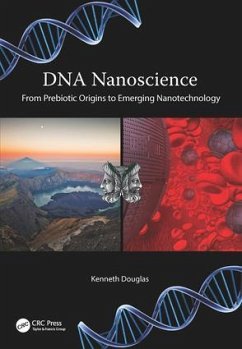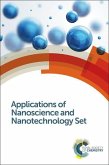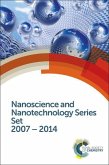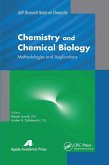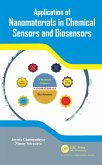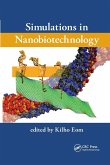- Broschiertes Buch
- Merkliste
- Auf die Merkliste
- Bewerten Bewerten
- Teilen
- Produkt teilen
- Produkterinnerung
- Produkterinnerung
DNA Nanoscience: From Prebiotic Origins to Emerging Nanotechnology melds two tales of DNA. One is a look at the first 35 years of DNA nanotechnology to better appreciate what lies ahead in this emerging field. The other story looks back 4 billion years to the possible origins of DNA which are shrouded in mystery. The book is divided into three parts comprised of 15 chapters and two Brief Interludes. Part I includes subjects underpinning the book such as a primer on DNA, the broader discipline of nanoscience, and experimental tools used by the principals in the narrative. Part II examines the…mehr
Andere Kunden interessierten sich auch für
![Applications of Nanoscience and Nanotechnology Set Applications of Nanoscience and Nanotechnology Set]() Applications of Nanoscience and Nanotechnology Set1.138,99 €
Applications of Nanoscience and Nanotechnology Set1.138,99 €![Nanoscience and Nanotechnology Series Set Nanoscience and Nanotechnology Series Set]() Nanoscience and Nanotechnology Series Set5.310,99 €
Nanoscience and Nanotechnology Series Set5.310,99 €![Modern Physical Chemistry: Engineering Models, Materials, and Methods with Applications Modern Physical Chemistry: Engineering Models, Materials, and Methods with Applications]() Modern Physical Chemistry: Engineering Models, Materials, and Methods with Applications103,99 €
Modern Physical Chemistry: Engineering Models, Materials, and Methods with Applications103,99 €![Chemistry and Chemical Biology Chemistry and Chemical Biology]() Chemistry and Chemical Biology103,99 €
Chemistry and Chemical Biology103,99 €![Application of Nanomaterials in Chemical Sensors and Biosensors Application of Nanomaterials in Chemical Sensors and Biosensors]() Jayeeta ChattopadhyayApplication of Nanomaterials in Chemical Sensors and Biosensors87,99 €
Jayeeta ChattopadhyayApplication of Nanomaterials in Chemical Sensors and Biosensors87,99 €![Simulations in Nanobiotechnology Simulations in Nanobiotechnology]() Simulations in Nanobiotechnology81,99 €
Simulations in Nanobiotechnology81,99 €![Polymer and Polymer-Hybrid Nanoparticles Polymer and Polymer-Hybrid Nanoparticles]() Stanislav RangelovPolymer and Polymer-Hybrid Nanoparticles83,99 €
Stanislav RangelovPolymer and Polymer-Hybrid Nanoparticles83,99 €-
-
-
DNA Nanoscience: From Prebiotic Origins to Emerging Nanotechnology melds two tales of DNA. One is a look at the first 35 years of DNA nanotechnology to better appreciate what lies ahead in this emerging field. The other story looks back 4 billion years to the possible origins of DNA which are shrouded in mystery. The book is divided into three parts comprised of 15 chapters and two Brief Interludes. Part I includes subjects underpinning the book such as a primer on DNA, the broader discipline of nanoscience, and experimental tools used by the principals in the narrative. Part II examines the field of structural DNA nanotechnology, founded by biochemist/crystallographer Nadrian Seeman, that uses DNA as a construction material for nanoscale structures and devices, rather than as a genetic material. Part III looks at the work of physicists Noel Clark and Tommaso Bellini who found that short DNA (nanoDNA) forms liquid crystals that act as a structural gatekeeper, orchestrating a series of self-assembly processes using nanoDNA. This led to an explanation of the polymeric structure of DNA and of how life may have emerged from the prebiotic clutter.
Hinweis: Dieser Artikel kann nur an eine deutsche Lieferadresse ausgeliefert werden.
Hinweis: Dieser Artikel kann nur an eine deutsche Lieferadresse ausgeliefert werden.
Produktdetails
- Produktdetails
- Verlag: CRC Press
- Seitenzahl: 456
- Erscheinungstermin: 15. August 2016
- Englisch
- Abmessung: 254mm x 179mm x 25mm
- Gewicht: 956g
- ISBN-13: 9781498750127
- ISBN-10: 1498750125
- Artikelnr.: 45667952
- Herstellerkennzeichnung
- Libri GmbH
- Europaallee 1
- 36244 Bad Hersfeld
- gpsr@libri.de
- Verlag: CRC Press
- Seitenzahl: 456
- Erscheinungstermin: 15. August 2016
- Englisch
- Abmessung: 254mm x 179mm x 25mm
- Gewicht: 956g
- ISBN-13: 9781498750127
- ISBN-10: 1498750125
- Artikelnr.: 45667952
- Herstellerkennzeichnung
- Libri GmbH
- Europaallee 1
- 36244 Bad Hersfeld
- gpsr@libri.de
Kenneth Douglas is a member of the Research Faculty in the Department of Physics at the University of Colorado-Boulder. He received his B.A. (mathematics) and M.S. (physics) at the University of Chicago and his Ph.D. (physics) at the University of Colorado-Boulder. His area of specialization is biomimetic nanofabrication. He devised a strategy that employs the surface layers of bacterial extremophiles - e.g., Sulfolobus acidocaldarius - as masks to fabricate nanoscale periodic patterns on inorganic substrates. He is co-inventor of the first-ever U.S. patents for parallel fabrication of nanoscale multi-device structures. His work has appeared in Science, Nature, Biophysical Journal, Applied Physics Letters, Physical Review B, Surface Science, FEMS Microbiology Reviews, Journal of Applied Physics, Popular Science and elsewhere. Douglas has authored multiple book chapters and seven U.S. patents.
A Note to the Reader
Preface
Author Biography
Acknowledgments
INTRODUCTION: Grandma Needs a Walker
PART I - The Story Line and Its Underpinnings
CHAPTER ONE - Down the Road and the Gemisch
Dramatis Personae, Part I: Nadrian Seeman
Molecular Crystals-Inspiration from Escher
Perspiration and Reinvention
Dramatis Personae, Part II: Noel Clark, Tommaso Bellini
Liquid Crystals and Self-Assembly
Seeman, Bellini and Clark, and Base Complementarity
Conventional Wisdom and an Alternative View
Endnotes
CHAPTER TWO - DNA: The Molecule That Makes Life Work-and More
Erwin Chargaff
Rosalind Franklin
James Watson, Francis Crick, and Maurice Wilkins
DNA Sequencing
Polyacrylamide Gel Electrophoresis (PAGE)
DNA Synthesis
Exercises for Chapter Two
Endnotes
CHAPTER THREE - Travels to the Nanoworld
The Scanning Tunneling Microscope (STM)
Moving Atoms With an STM
Standing Waves
Quantum Corrals
Nanomethodology
Spherical Nucleic Acids (SNAs)
Biodiagnostic Detection Using SNAs
Exercises for Chapter Three
Endnotes
CHAPTER FOUR-Liquid Crystals: Nature's Delicate Phase of Matter
Phase Transitions
Classes of Liquid Crystals
Cell Membranes and the Langmuir Trough
Micelles
Liquid Crystal Displays
Exercises for Chapter Four
Endnotes
CHAPTER FIVE - Tools of the Trade
Polarized Light Microscopy
Liquid Crystal Texture Seen Through a Depolarized Light Microscope
Transmission Electron Microscopy (TEM)
Atomic Force Microscopy (AFM)
X-Ray Diffraction and Bragg's Law
The Phase Problem
Synchrotron X-Ray Diffraction
Exercises for Chapter Five
Endnotes
PART II - The Emerging Technology: Nanomaterials Constructed From DNA
CHAPTER SIX - The Three Pillars of Structural DNA Nanotechnology
Branched DNA and DNA Junctions
Sticky Ends
Immobile Four-Arm DNA Junction
Two-Dimensional Ligation of DNA Junctions
Deconstruction of Concatenated Nucleic Acid Junctions
Macrocycles
Three-Dimensional Constructions and Catenanes
The DNA Cube
Exercises for Chapter Six
Endnotes
CHAPTER SEVEN - Motif Generation, Sequence Design, Nanomechanical Devices
Flexible Junctions Redux
The Double-Crossover (DX) Molecule
Design and Self-Assembly of Two-Dimensional DNA Crystals
Two-Dimensional Nanoparticle Arrays
Sequence Design
Nanomechanical Devices
Exercises for Chapter Seven
Endnotes
CHAPTER EIGHT-DNA Origami, DNA Bricks
Scaffolded DNA Origami
DNA Origami Patterns
Strand Invasion also called Strand Displacement
DNA Origami With Complex Curvatures in Three Dimensions
DNA Tiles in Two Dimensions
DNA Bricks in Three Dimensions
DNA Brick Shapes in Three Dimensions
DNA Brick Crystals
Seeman, Rothemund, and Yin
Exercises for Chapter Eight
Endnotes
CHAPTER NINE - DNA Assembly Line and the Triumph of Tensegrity Triangles
DNA Nanoscale Assembly Line (Overview)
DNA Walkers
DNA Machines and Paranemic Crossover Molecules
DNA Cassette With Robot Arm and DNA Origami Track
DNA Assembly Line
The Triumph of Tensegrity Triangles
Exercises for Chapter Nine
Endnotes
BRIEF INTERLUDE I - Back to Methuselah
Molecular-Scale Weaving
Moors and Crossover Molecules
Tensegrity Sculpting
Mayan Pottery, Chirality, and the Handedness of Life
Endnotes
CHAPTER TEN - DNA Nanotechnology Meets the Real World
Cell Membrane Channels
Synthetic Membrane Channels via DNA Nanotechnology
Current Gating
Channels as Single-Molecule Sensors
Molecular Nanorobots Built by DNA Origami: Cell-Targeted Drug Delivery
Tests of Nanorobot Function
Test of Binding Discrimination: Healthy Cells vs. Leukemia Cells (NK Cells)
Exercises for Chapter Ten
Endnotes
PART III - The Possible Origins of Life's Information Carrier
CHAPTER ELEVEN - Chance Findings
Onsager's Criterion for an Isotropic-Nematic Liquid Crystal Phase
Transition
NanoDNA Seems to Violate Onsager's Venerable Criterion
The Details
Shifting Gears
Phase Separation into Liquid Crystal Droplets
The Depletion Interaction
Flory's Model
Exercises for Chapter Eleven
Endnotes
CHAPTER TWELVE - Unexpected Consequences
Hierarchical Self-Assembly
NanoRNA
Blunt Ends and Sticky Ends
Base Stacking Forces
The Scope of the Self-Assembly Mechanisms of Nucleic Acids
Random-Sequence NanoDNA
The Strange World of Random-Sequence NanoDNA
Liquid Crystal Ordering of Random-Sequence NanoDNA
Non-Equilibrium Statistical Mechanics: Kinetic Arrest and Nonergodic
Behavior
Exercises for Chapter Twelve
Endnotes
CHAPTER THIRTEEN - Ligation: Blest be the Tie That Binds
NanoDNA Stacking: Weak Physical Attractive Forces vs. Chemical Ligation
Abiotic Ligation Experiments with EDC
The Scheme: Polyethylene glycol (PEG)-Induced Phase Separation
Gel Electrophoresis of D1p Oligomers With Polyacrylamide and Agarose Gels
Another Stellar Contribution by Chemist Paul J. Flory
Analysis of Gel Profiles: The Experimental Data is Well Described by the
Flory Model
The Lowdown on Ligation Efficiency
The Liquid Crystal Phase as Gatekeeper
Cascaded Phase Separation
Exercises for Chapter Thirteen
Endnotes
BRIEF INTERLUDE II - The Handedness of Life
Chirality
Life is Homochiral
Macroscopic Chiral Helical Precession of Molecular Orientation
Bellini and Clark Examine NanoDNA Chirality
A Lighter Take on Chirality
Exercises for Brief Interlude II
Endnotes
CHAPTER FOURTEEN - All the World's a Stage and Life's a Play-Did it
Arise From Clay?
Emergence and Complexity
Miller-Urey Experiment
RNA World Hypothesis
Other Plausible Venues
Replicator-First vs. Metabolism-First
Feats of Clay
The Lipid World
Liquid Crystals in the Work of Deamer and the Work of Bellini/Clark
Manfred Eigen and Stuart Kauffman
Exercises for Chapter Fourteen
Endnotes
CHAPTER FIFTEEN - The Passover Question: Why is This Origins Proposal
Different From All Other Proposals?
Emergence and Broken Symmetry
About-Face
Occam's Razor
The RNA World Revisited
Sticky Business, Part I: What Constitutes Plausible Prebiotic Conditions?
Sticky Business, Part II: The Origins Question-Whose Home Turf Is It?
Discovering the Physical Processes that Enabled the Chemistry of Life
Metabolism-First Revisited
Computer Simulations and Mathematical Modeling
An Ancient "Liquid Crystal World"
Endnotes
Epilogue
APPENDIX - Texture of Liquid Crystal Optical Images
Smectic Phase Liquid Crystal Texture
Bent-Core Molecules
Extinction Brushes
Chiral Nematic Texture of NanoDNA Liquid Crystals
Columnar Texture of NanoDNA Liquid Crystals
Endnotes
Glossary
Index
Preface
Author Biography
Acknowledgments
INTRODUCTION: Grandma Needs a Walker
PART I - The Story Line and Its Underpinnings
CHAPTER ONE - Down the Road and the Gemisch
Dramatis Personae, Part I: Nadrian Seeman
Molecular Crystals-Inspiration from Escher
Perspiration and Reinvention
Dramatis Personae, Part II: Noel Clark, Tommaso Bellini
Liquid Crystals and Self-Assembly
Seeman, Bellini and Clark, and Base Complementarity
Conventional Wisdom and an Alternative View
Endnotes
CHAPTER TWO - DNA: The Molecule That Makes Life Work-and More
Erwin Chargaff
Rosalind Franklin
James Watson, Francis Crick, and Maurice Wilkins
DNA Sequencing
Polyacrylamide Gel Electrophoresis (PAGE)
DNA Synthesis
Exercises for Chapter Two
Endnotes
CHAPTER THREE - Travels to the Nanoworld
The Scanning Tunneling Microscope (STM)
Moving Atoms With an STM
Standing Waves
Quantum Corrals
Nanomethodology
Spherical Nucleic Acids (SNAs)
Biodiagnostic Detection Using SNAs
Exercises for Chapter Three
Endnotes
CHAPTER FOUR-Liquid Crystals: Nature's Delicate Phase of Matter
Phase Transitions
Classes of Liquid Crystals
Cell Membranes and the Langmuir Trough
Micelles
Liquid Crystal Displays
Exercises for Chapter Four
Endnotes
CHAPTER FIVE - Tools of the Trade
Polarized Light Microscopy
Liquid Crystal Texture Seen Through a Depolarized Light Microscope
Transmission Electron Microscopy (TEM)
Atomic Force Microscopy (AFM)
X-Ray Diffraction and Bragg's Law
The Phase Problem
Synchrotron X-Ray Diffraction
Exercises for Chapter Five
Endnotes
PART II - The Emerging Technology: Nanomaterials Constructed From DNA
CHAPTER SIX - The Three Pillars of Structural DNA Nanotechnology
Branched DNA and DNA Junctions
Sticky Ends
Immobile Four-Arm DNA Junction
Two-Dimensional Ligation of DNA Junctions
Deconstruction of Concatenated Nucleic Acid Junctions
Macrocycles
Three-Dimensional Constructions and Catenanes
The DNA Cube
Exercises for Chapter Six
Endnotes
CHAPTER SEVEN - Motif Generation, Sequence Design, Nanomechanical Devices
Flexible Junctions Redux
The Double-Crossover (DX) Molecule
Design and Self-Assembly of Two-Dimensional DNA Crystals
Two-Dimensional Nanoparticle Arrays
Sequence Design
Nanomechanical Devices
Exercises for Chapter Seven
Endnotes
CHAPTER EIGHT-DNA Origami, DNA Bricks
Scaffolded DNA Origami
DNA Origami Patterns
Strand Invasion also called Strand Displacement
DNA Origami With Complex Curvatures in Three Dimensions
DNA Tiles in Two Dimensions
DNA Bricks in Three Dimensions
DNA Brick Shapes in Three Dimensions
DNA Brick Crystals
Seeman, Rothemund, and Yin
Exercises for Chapter Eight
Endnotes
CHAPTER NINE - DNA Assembly Line and the Triumph of Tensegrity Triangles
DNA Nanoscale Assembly Line (Overview)
DNA Walkers
DNA Machines and Paranemic Crossover Molecules
DNA Cassette With Robot Arm and DNA Origami Track
DNA Assembly Line
The Triumph of Tensegrity Triangles
Exercises for Chapter Nine
Endnotes
BRIEF INTERLUDE I - Back to Methuselah
Molecular-Scale Weaving
Moors and Crossover Molecules
Tensegrity Sculpting
Mayan Pottery, Chirality, and the Handedness of Life
Endnotes
CHAPTER TEN - DNA Nanotechnology Meets the Real World
Cell Membrane Channels
Synthetic Membrane Channels via DNA Nanotechnology
Current Gating
Channels as Single-Molecule Sensors
Molecular Nanorobots Built by DNA Origami: Cell-Targeted Drug Delivery
Tests of Nanorobot Function
Test of Binding Discrimination: Healthy Cells vs. Leukemia Cells (NK Cells)
Exercises for Chapter Ten
Endnotes
PART III - The Possible Origins of Life's Information Carrier
CHAPTER ELEVEN - Chance Findings
Onsager's Criterion for an Isotropic-Nematic Liquid Crystal Phase
Transition
NanoDNA Seems to Violate Onsager's Venerable Criterion
The Details
Shifting Gears
Phase Separation into Liquid Crystal Droplets
The Depletion Interaction
Flory's Model
Exercises for Chapter Eleven
Endnotes
CHAPTER TWELVE - Unexpected Consequences
Hierarchical Self-Assembly
NanoRNA
Blunt Ends and Sticky Ends
Base Stacking Forces
The Scope of the Self-Assembly Mechanisms of Nucleic Acids
Random-Sequence NanoDNA
The Strange World of Random-Sequence NanoDNA
Liquid Crystal Ordering of Random-Sequence NanoDNA
Non-Equilibrium Statistical Mechanics: Kinetic Arrest and Nonergodic
Behavior
Exercises for Chapter Twelve
Endnotes
CHAPTER THIRTEEN - Ligation: Blest be the Tie That Binds
NanoDNA Stacking: Weak Physical Attractive Forces vs. Chemical Ligation
Abiotic Ligation Experiments with EDC
The Scheme: Polyethylene glycol (PEG)-Induced Phase Separation
Gel Electrophoresis of D1p Oligomers With Polyacrylamide and Agarose Gels
Another Stellar Contribution by Chemist Paul J. Flory
Analysis of Gel Profiles: The Experimental Data is Well Described by the
Flory Model
The Lowdown on Ligation Efficiency
The Liquid Crystal Phase as Gatekeeper
Cascaded Phase Separation
Exercises for Chapter Thirteen
Endnotes
BRIEF INTERLUDE II - The Handedness of Life
Chirality
Life is Homochiral
Macroscopic Chiral Helical Precession of Molecular Orientation
Bellini and Clark Examine NanoDNA Chirality
A Lighter Take on Chirality
Exercises for Brief Interlude II
Endnotes
CHAPTER FOURTEEN - All the World's a Stage and Life's a Play-Did it
Arise From Clay?
Emergence and Complexity
Miller-Urey Experiment
RNA World Hypothesis
Other Plausible Venues
Replicator-First vs. Metabolism-First
Feats of Clay
The Lipid World
Liquid Crystals in the Work of Deamer and the Work of Bellini/Clark
Manfred Eigen and Stuart Kauffman
Exercises for Chapter Fourteen
Endnotes
CHAPTER FIFTEEN - The Passover Question: Why is This Origins Proposal
Different From All Other Proposals?
Emergence and Broken Symmetry
About-Face
Occam's Razor
The RNA World Revisited
Sticky Business, Part I: What Constitutes Plausible Prebiotic Conditions?
Sticky Business, Part II: The Origins Question-Whose Home Turf Is It?
Discovering the Physical Processes that Enabled the Chemistry of Life
Metabolism-First Revisited
Computer Simulations and Mathematical Modeling
An Ancient "Liquid Crystal World"
Endnotes
Epilogue
APPENDIX - Texture of Liquid Crystal Optical Images
Smectic Phase Liquid Crystal Texture
Bent-Core Molecules
Extinction Brushes
Chiral Nematic Texture of NanoDNA Liquid Crystals
Columnar Texture of NanoDNA Liquid Crystals
Endnotes
Glossary
Index
A Note to the Reader
Preface
Author Biography
Acknowledgments
INTRODUCTION: Grandma Needs a Walker
PART I - The Story Line and Its Underpinnings
CHAPTER ONE - Down the Road and the Gemisch
Dramatis Personae, Part I: Nadrian Seeman
Molecular Crystals-Inspiration from Escher
Perspiration and Reinvention
Dramatis Personae, Part II: Noel Clark, Tommaso Bellini
Liquid Crystals and Self-Assembly
Seeman, Bellini and Clark, and Base Complementarity
Conventional Wisdom and an Alternative View
Endnotes
CHAPTER TWO - DNA: The Molecule That Makes Life Work-and More
Erwin Chargaff
Rosalind Franklin
James Watson, Francis Crick, and Maurice Wilkins
DNA Sequencing
Polyacrylamide Gel Electrophoresis (PAGE)
DNA Synthesis
Exercises for Chapter Two
Endnotes
CHAPTER THREE - Travels to the Nanoworld
The Scanning Tunneling Microscope (STM)
Moving Atoms With an STM
Standing Waves
Quantum Corrals
Nanomethodology
Spherical Nucleic Acids (SNAs)
Biodiagnostic Detection Using SNAs
Exercises for Chapter Three
Endnotes
CHAPTER FOUR-Liquid Crystals: Nature's Delicate Phase of Matter
Phase Transitions
Classes of Liquid Crystals
Cell Membranes and the Langmuir Trough
Micelles
Liquid Crystal Displays
Exercises for Chapter Four
Endnotes
CHAPTER FIVE - Tools of the Trade
Polarized Light Microscopy
Liquid Crystal Texture Seen Through a Depolarized Light Microscope
Transmission Electron Microscopy (TEM)
Atomic Force Microscopy (AFM)
X-Ray Diffraction and Bragg's Law
The Phase Problem
Synchrotron X-Ray Diffraction
Exercises for Chapter Five
Endnotes
PART II - The Emerging Technology: Nanomaterials Constructed From DNA
CHAPTER SIX - The Three Pillars of Structural DNA Nanotechnology
Branched DNA and DNA Junctions
Sticky Ends
Immobile Four-Arm DNA Junction
Two-Dimensional Ligation of DNA Junctions
Deconstruction of Concatenated Nucleic Acid Junctions
Macrocycles
Three-Dimensional Constructions and Catenanes
The DNA Cube
Exercises for Chapter Six
Endnotes
CHAPTER SEVEN - Motif Generation, Sequence Design, Nanomechanical Devices
Flexible Junctions Redux
The Double-Crossover (DX) Molecule
Design and Self-Assembly of Two-Dimensional DNA Crystals
Two-Dimensional Nanoparticle Arrays
Sequence Design
Nanomechanical Devices
Exercises for Chapter Seven
Endnotes
CHAPTER EIGHT-DNA Origami, DNA Bricks
Scaffolded DNA Origami
DNA Origami Patterns
Strand Invasion also called Strand Displacement
DNA Origami With Complex Curvatures in Three Dimensions
DNA Tiles in Two Dimensions
DNA Bricks in Three Dimensions
DNA Brick Shapes in Three Dimensions
DNA Brick Crystals
Seeman, Rothemund, and Yin
Exercises for Chapter Eight
Endnotes
CHAPTER NINE - DNA Assembly Line and the Triumph of Tensegrity Triangles
DNA Nanoscale Assembly Line (Overview)
DNA Walkers
DNA Machines and Paranemic Crossover Molecules
DNA Cassette With Robot Arm and DNA Origami Track
DNA Assembly Line
The Triumph of Tensegrity Triangles
Exercises for Chapter Nine
Endnotes
BRIEF INTERLUDE I - Back to Methuselah
Molecular-Scale Weaving
Moors and Crossover Molecules
Tensegrity Sculpting
Mayan Pottery, Chirality, and the Handedness of Life
Endnotes
CHAPTER TEN - DNA Nanotechnology Meets the Real World
Cell Membrane Channels
Synthetic Membrane Channels via DNA Nanotechnology
Current Gating
Channels as Single-Molecule Sensors
Molecular Nanorobots Built by DNA Origami: Cell-Targeted Drug Delivery
Tests of Nanorobot Function
Test of Binding Discrimination: Healthy Cells vs. Leukemia Cells (NK Cells)
Exercises for Chapter Ten
Endnotes
PART III - The Possible Origins of Life's Information Carrier
CHAPTER ELEVEN - Chance Findings
Onsager's Criterion for an Isotropic-Nematic Liquid Crystal Phase
Transition
NanoDNA Seems to Violate Onsager's Venerable Criterion
The Details
Shifting Gears
Phase Separation into Liquid Crystal Droplets
The Depletion Interaction
Flory's Model
Exercises for Chapter Eleven
Endnotes
CHAPTER TWELVE - Unexpected Consequences
Hierarchical Self-Assembly
NanoRNA
Blunt Ends and Sticky Ends
Base Stacking Forces
The Scope of the Self-Assembly Mechanisms of Nucleic Acids
Random-Sequence NanoDNA
The Strange World of Random-Sequence NanoDNA
Liquid Crystal Ordering of Random-Sequence NanoDNA
Non-Equilibrium Statistical Mechanics: Kinetic Arrest and Nonergodic
Behavior
Exercises for Chapter Twelve
Endnotes
CHAPTER THIRTEEN - Ligation: Blest be the Tie That Binds
NanoDNA Stacking: Weak Physical Attractive Forces vs. Chemical Ligation
Abiotic Ligation Experiments with EDC
The Scheme: Polyethylene glycol (PEG)-Induced Phase Separation
Gel Electrophoresis of D1p Oligomers With Polyacrylamide and Agarose Gels
Another Stellar Contribution by Chemist Paul J. Flory
Analysis of Gel Profiles: The Experimental Data is Well Described by the
Flory Model
The Lowdown on Ligation Efficiency
The Liquid Crystal Phase as Gatekeeper
Cascaded Phase Separation
Exercises for Chapter Thirteen
Endnotes
BRIEF INTERLUDE II - The Handedness of Life
Chirality
Life is Homochiral
Macroscopic Chiral Helical Precession of Molecular Orientation
Bellini and Clark Examine NanoDNA Chirality
A Lighter Take on Chirality
Exercises for Brief Interlude II
Endnotes
CHAPTER FOURTEEN - All the World's a Stage and Life's a Play-Did it
Arise From Clay?
Emergence and Complexity
Miller-Urey Experiment
RNA World Hypothesis
Other Plausible Venues
Replicator-First vs. Metabolism-First
Feats of Clay
The Lipid World
Liquid Crystals in the Work of Deamer and the Work of Bellini/Clark
Manfred Eigen and Stuart Kauffman
Exercises for Chapter Fourteen
Endnotes
CHAPTER FIFTEEN - The Passover Question: Why is This Origins Proposal
Different From All Other Proposals?
Emergence and Broken Symmetry
About-Face
Occam's Razor
The RNA World Revisited
Sticky Business, Part I: What Constitutes Plausible Prebiotic Conditions?
Sticky Business, Part II: The Origins Question-Whose Home Turf Is It?
Discovering the Physical Processes that Enabled the Chemistry of Life
Metabolism-First Revisited
Computer Simulations and Mathematical Modeling
An Ancient "Liquid Crystal World"
Endnotes
Epilogue
APPENDIX - Texture of Liquid Crystal Optical Images
Smectic Phase Liquid Crystal Texture
Bent-Core Molecules
Extinction Brushes
Chiral Nematic Texture of NanoDNA Liquid Crystals
Columnar Texture of NanoDNA Liquid Crystals
Endnotes
Glossary
Index
Preface
Author Biography
Acknowledgments
INTRODUCTION: Grandma Needs a Walker
PART I - The Story Line and Its Underpinnings
CHAPTER ONE - Down the Road and the Gemisch
Dramatis Personae, Part I: Nadrian Seeman
Molecular Crystals-Inspiration from Escher
Perspiration and Reinvention
Dramatis Personae, Part II: Noel Clark, Tommaso Bellini
Liquid Crystals and Self-Assembly
Seeman, Bellini and Clark, and Base Complementarity
Conventional Wisdom and an Alternative View
Endnotes
CHAPTER TWO - DNA: The Molecule That Makes Life Work-and More
Erwin Chargaff
Rosalind Franklin
James Watson, Francis Crick, and Maurice Wilkins
DNA Sequencing
Polyacrylamide Gel Electrophoresis (PAGE)
DNA Synthesis
Exercises for Chapter Two
Endnotes
CHAPTER THREE - Travels to the Nanoworld
The Scanning Tunneling Microscope (STM)
Moving Atoms With an STM
Standing Waves
Quantum Corrals
Nanomethodology
Spherical Nucleic Acids (SNAs)
Biodiagnostic Detection Using SNAs
Exercises for Chapter Three
Endnotes
CHAPTER FOUR-Liquid Crystals: Nature's Delicate Phase of Matter
Phase Transitions
Classes of Liquid Crystals
Cell Membranes and the Langmuir Trough
Micelles
Liquid Crystal Displays
Exercises for Chapter Four
Endnotes
CHAPTER FIVE - Tools of the Trade
Polarized Light Microscopy
Liquid Crystal Texture Seen Through a Depolarized Light Microscope
Transmission Electron Microscopy (TEM)
Atomic Force Microscopy (AFM)
X-Ray Diffraction and Bragg's Law
The Phase Problem
Synchrotron X-Ray Diffraction
Exercises for Chapter Five
Endnotes
PART II - The Emerging Technology: Nanomaterials Constructed From DNA
CHAPTER SIX - The Three Pillars of Structural DNA Nanotechnology
Branched DNA and DNA Junctions
Sticky Ends
Immobile Four-Arm DNA Junction
Two-Dimensional Ligation of DNA Junctions
Deconstruction of Concatenated Nucleic Acid Junctions
Macrocycles
Three-Dimensional Constructions and Catenanes
The DNA Cube
Exercises for Chapter Six
Endnotes
CHAPTER SEVEN - Motif Generation, Sequence Design, Nanomechanical Devices
Flexible Junctions Redux
The Double-Crossover (DX) Molecule
Design and Self-Assembly of Two-Dimensional DNA Crystals
Two-Dimensional Nanoparticle Arrays
Sequence Design
Nanomechanical Devices
Exercises for Chapter Seven
Endnotes
CHAPTER EIGHT-DNA Origami, DNA Bricks
Scaffolded DNA Origami
DNA Origami Patterns
Strand Invasion also called Strand Displacement
DNA Origami With Complex Curvatures in Three Dimensions
DNA Tiles in Two Dimensions
DNA Bricks in Three Dimensions
DNA Brick Shapes in Three Dimensions
DNA Brick Crystals
Seeman, Rothemund, and Yin
Exercises for Chapter Eight
Endnotes
CHAPTER NINE - DNA Assembly Line and the Triumph of Tensegrity Triangles
DNA Nanoscale Assembly Line (Overview)
DNA Walkers
DNA Machines and Paranemic Crossover Molecules
DNA Cassette With Robot Arm and DNA Origami Track
DNA Assembly Line
The Triumph of Tensegrity Triangles
Exercises for Chapter Nine
Endnotes
BRIEF INTERLUDE I - Back to Methuselah
Molecular-Scale Weaving
Moors and Crossover Molecules
Tensegrity Sculpting
Mayan Pottery, Chirality, and the Handedness of Life
Endnotes
CHAPTER TEN - DNA Nanotechnology Meets the Real World
Cell Membrane Channels
Synthetic Membrane Channels via DNA Nanotechnology
Current Gating
Channels as Single-Molecule Sensors
Molecular Nanorobots Built by DNA Origami: Cell-Targeted Drug Delivery
Tests of Nanorobot Function
Test of Binding Discrimination: Healthy Cells vs. Leukemia Cells (NK Cells)
Exercises for Chapter Ten
Endnotes
PART III - The Possible Origins of Life's Information Carrier
CHAPTER ELEVEN - Chance Findings
Onsager's Criterion for an Isotropic-Nematic Liquid Crystal Phase
Transition
NanoDNA Seems to Violate Onsager's Venerable Criterion
The Details
Shifting Gears
Phase Separation into Liquid Crystal Droplets
The Depletion Interaction
Flory's Model
Exercises for Chapter Eleven
Endnotes
CHAPTER TWELVE - Unexpected Consequences
Hierarchical Self-Assembly
NanoRNA
Blunt Ends and Sticky Ends
Base Stacking Forces
The Scope of the Self-Assembly Mechanisms of Nucleic Acids
Random-Sequence NanoDNA
The Strange World of Random-Sequence NanoDNA
Liquid Crystal Ordering of Random-Sequence NanoDNA
Non-Equilibrium Statistical Mechanics: Kinetic Arrest and Nonergodic
Behavior
Exercises for Chapter Twelve
Endnotes
CHAPTER THIRTEEN - Ligation: Blest be the Tie That Binds
NanoDNA Stacking: Weak Physical Attractive Forces vs. Chemical Ligation
Abiotic Ligation Experiments with EDC
The Scheme: Polyethylene glycol (PEG)-Induced Phase Separation
Gel Electrophoresis of D1p Oligomers With Polyacrylamide and Agarose Gels
Another Stellar Contribution by Chemist Paul J. Flory
Analysis of Gel Profiles: The Experimental Data is Well Described by the
Flory Model
The Lowdown on Ligation Efficiency
The Liquid Crystal Phase as Gatekeeper
Cascaded Phase Separation
Exercises for Chapter Thirteen
Endnotes
BRIEF INTERLUDE II - The Handedness of Life
Chirality
Life is Homochiral
Macroscopic Chiral Helical Precession of Molecular Orientation
Bellini and Clark Examine NanoDNA Chirality
A Lighter Take on Chirality
Exercises for Brief Interlude II
Endnotes
CHAPTER FOURTEEN - All the World's a Stage and Life's a Play-Did it
Arise From Clay?
Emergence and Complexity
Miller-Urey Experiment
RNA World Hypothesis
Other Plausible Venues
Replicator-First vs. Metabolism-First
Feats of Clay
The Lipid World
Liquid Crystals in the Work of Deamer and the Work of Bellini/Clark
Manfred Eigen and Stuart Kauffman
Exercises for Chapter Fourteen
Endnotes
CHAPTER FIFTEEN - The Passover Question: Why is This Origins Proposal
Different From All Other Proposals?
Emergence and Broken Symmetry
About-Face
Occam's Razor
The RNA World Revisited
Sticky Business, Part I: What Constitutes Plausible Prebiotic Conditions?
Sticky Business, Part II: The Origins Question-Whose Home Turf Is It?
Discovering the Physical Processes that Enabled the Chemistry of Life
Metabolism-First Revisited
Computer Simulations and Mathematical Modeling
An Ancient "Liquid Crystal World"
Endnotes
Epilogue
APPENDIX - Texture of Liquid Crystal Optical Images
Smectic Phase Liquid Crystal Texture
Bent-Core Molecules
Extinction Brushes
Chiral Nematic Texture of NanoDNA Liquid Crystals
Columnar Texture of NanoDNA Liquid Crystals
Endnotes
Glossary
Index

